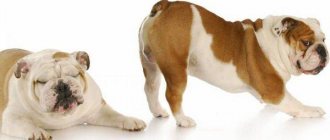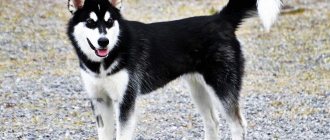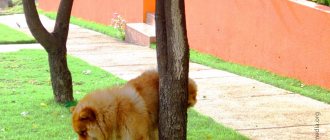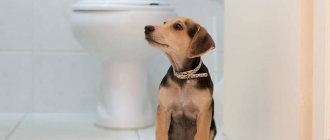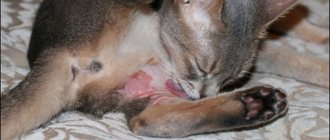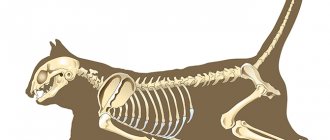How often can you hear complaints from dog owners about the unpleasant odor left by the liquid that the pet sprayed from the anal glands. But this is not the only trouble associated with this body. Sometimes the dog suddenly bleeds from that very rear place, and it furiously licks “under its tail,” and it can also “scratch its butt,” and ride it unsightly on the floor or ground. What is happening to our pets? Is all this normal, or do these signs indicate health problems?
In almost all cases, except for marking territory, any manifestation of a dog’s interest in its own glands can be considered a deviation from the norm. As soon as they begin to disturb the animal, you need to immediately examine it and take action.
Functions of anal glands in dogs
The anal glands (sines), through which dogs and cats release their scent, are located under the skin near the anus, their ducts open directly into the anus. To find out the exact location of the organ, take a watch: the glands are located around the anus where the hands will be at 20:00 and 4:00. They are a symbiosis of sweat and sebaceous ducts.
The anal glands secrete a hormonal odorant that has a unique odor for each animal of the same species. Therefore, we can say that every dog smells differently. It is for the purpose of remembering and comparing the scent that dogs and cats, upon seeing a “colleague,” immediately begin to sniff the anal area. This is how they get to know and study their new friend.
The structure of the anal glands in dogs
Why does inflammation of the anal glands occur in dogs?
In the wild, dogs and cats constantly expel fluid from their anal glands to mark their territory, thereby warning other animals that the space has an owner. Marking from anal secretions is much stronger than marking from urine and does not easily rub off. As for domestic animals, many of them, due to domestication and selection, have lost the ability to voluntarily contract their anal muscles in order to spray secretions.
Obesity also plays a role. Approximately 60% of pets suffer from obesity due to the wrong attitude of their owners. The accumulation of fat around the muscles of the anal glands leads to a problem - the inability to “squeeze” the contents of the glands naturally. That's why dogs have to do all those licking, scratching, and butt-riding tricks. This is how they strive to get rid of the accumulated secretion.
If the fluid accumulates, the dog's anal glands become blocked, become inflamed, and even rupture may occur. It's quite painful. Plus, there is a threat of a secondary infection, with even more serious consequences. Sometimes surgery is required to remove the swelling, or, as a rule, the dog is prescribed long-term antibiotic therapy. On their own, without treatment, the inflamed glands cannot return to normal function.
Belencon
Editor of the section “Endocrinology”
Chief physician of the Bely Klyk branch in Strogin, head of the diagnostic and treatment department of the Bely Klyk veterinary clinics.
Born in the Far East on November 14, 1975. In 1992, he moved with his family to Moscow, where he graduated from school. In 1993, he entered the Moscow State University of Applied Biotechnology at the Veterinary and Sanitary Faculty, from which he graduated with honors in 1998.
On January 7, 1999, he began working at the newly opened Bely Klyk clinic as a veterinary assistant, a year later he began to conduct independent appointments, and was eventually appointed head physician of the clinic’s branch in Strogin. His interest in veterinary endocrinology, having once arisen, does not fade to this day. In this area, Belenson achieved considerable success. It was possible to establish the diagnosis of common endocrine diseases of dogs and cats, to gain experience in the treatment of diabetes mellitus, Cushing's syndrome, hypothyroidism, Addison's disease and some other endocrine pathologies.
In addition to his work as head physician and scientific activities, Maxim Mikhailovich generously shares his knowledge and accumulated experience. The blog, accessible to both professionals and ordinary pet owners, publishes articles on the diagnosis and treatment of the most common endocrine disorders in dogs and cats. Participates in the preparation of master classes. He gives lectures at various events dedicated to advanced training of veterinarians, and takes part in the annual Moscow Veterinary Congress as a speaker.
Signs of inflammation of the anal glands
Inflammation of the anal gland in dogs
Determining that your pet has problems in “this place” is quite simple:
- the dog is worried;
- constantly licks under the tail, and even tries to gnaw out the fur;
- often turns back, trying to grab the tail with its teeth;
- moves his butt on the floor;
- anus red and swollen;
- When you press on the glands, you feel a dense tumor.
Don’t wait until your dog’s glands become inflamed. At the first sign, carry out a cleansing procedure.
My dog keeps licking his private parts - vaginitis
If you notice that your dog's vulva is swollen (vaginx), this usually indicates that it is going through the heating season . From the first stage of his period, the dog's vulva increases in size and you will see initial bleeding, which causes him to constantly lick the genital area. If you notice this behavior when your dog is in a heatwave, you can be sure that this is the cause of both the licking and the inflammation coming from her vagina.
However, if your dog does not have typical heat symptoms but has vaginitis and is constantly licking the vagina, be aware of the following symptoms:
- Increased urination
- Difficulty urinating
- In tears
- Loss of appetite
- Mood swings
These symptoms indicate that she may be suffering from a urinary tract infection ( orcanine cystitis), such diseases, together with vaginal tumors, ovarian cysts or other pathologies, can only be diagnosed by a specialist. So if you suspect that any of these reasons may be the reason your dog is licking his genital area, don't hesitate to visit your veterinarian as soon as possible.
Cleaning and treating anal glands in dogs
There is a common myth that diet affects the health of the anal gland. You've probably heard or read online that certain foods containing fiber can help improve and increase the volume of stool, which, thanks to your dog's pushing during bowel movements, will regularly empty the anal glands. In fact, there is absolutely no scientific evidence to support this theory. The anatomy around the anus is so complex, and the force of stool coming out of the anus is so low, that the idea of solving the problem of gland cleansing through foods containing fiber is a misconception.
Some pets don't need any help and can clean out their ducts themselves because their anal glands are well-pronounced. Other pets need cleaning weekly. Another category of dogs falls into the range where cleaning treatments are needed every few weeks or months. It is important to find a regular interval that suits your pet's needs.
How to clean anal glands in dogs
Cleaning the anal glands should be done carefully!
Anal glands are also called anal sacs, and they are also called paraanal glands. The cleaning process itself is quite unpleasant, so many dog breeders turn to a veterinarian for this purpose. You can do it like this:
- Wear gloves and place the animal in a container where the liquid should drain. Ask an assistant to hold the pet, clasping it with your hands from the muzzle to the tail.
- Inspect the dog's rear, visually noting the pouches. After this, lift the tail up with one hand (not to the point of pain) - this will relieve tension from the perianal area, with the other, gently press on the swelling from the sides, bringing your fingers closer to the anus.
- The liquid is very disgusting in appearance and terribly smelling, it will flow out in a few seconds. It must be flushed down the drain immediately.
If the structure of the anal glands does not allow you to get rid of the secretion in such a simple way, then you will have to perform the operation in an even more unpleasant way.
- Lubricate your index finger with Vaseline or vegetable oil and insert it as gently as possible into the dog's anus. The finger should be held at a slight angle, pointing the phalanx towards the floor (as if from above).
- Feel for the gland, and grabbing it from the inside, help squeeze out the liquid with your thumb from the outside, moving your fingers towards the anus.
Harmless reasons
This phenomenon called butt rolling is often observed in long-haired dogs after they go to the toilet.
Long hair is certainly beautiful, but, as they say, there is another side to the coin. Feces can get tangled in the fur so that you won't even see it.
But the dog will feel discomfort and will rush to get rid of the stuck trouble by wiping its butt on the floor.
Another reason is similar. The dog may be trying to clean itself, not necessarily from the stool. Perhaps the fur near the anus is stained with urine, or even some kind of foreign substance.
The point is that dogs are quite clean, and if they cannot lick themselves somewhere, then they look for another way, for example, wiping them on the walls or floor.
There is a way out of this situation - a hygienic haircut. You can do this yourself if you have a certain skill, or take your pet to a groomer.
What to do if your dog has inflamed anal glands
The secretion contains many proteins and other elements that serve as an excellent substrate for the proliferation of bacteria. The more it accumulates, the more active and faster the inflammatory process will begin. If you notice signs of it, contact a specialist immediately. If it’s not too late, he will clean the anal sacs, process them, and then prescribe special suppositories (Proctosedyl, Ichthyol, etc.), which will have to be inserted into the dog’s butt.
It's done like this. Insert the candle and do not let it come out by pressing the anus with your fingers; after a minute the pet can be released. Small breeds do not require the entire dose of medication, so the candle must be inserted after cutting it.
If you miss the time, the bags may burst, and the purulent liquid will spread, finding a way out even through the skin. This process is called an abscess. With an abscess, a hole with erosive edges (similar to an ulcer) forms, through which a thick, purulent yellow substrate will ooze. The tissue around the fistula swells, and even large swelling is possible. The dog is worried and constantly tries to lick the wound. Here you cannot do without a veterinarian, since the glands still need to be cleaned, rinsed, and a drainage tube must be installed to drain the remaining pus.
It will take a long time to treat inflammation of the anal glands. You will also need to use anti-inflammatory suppositories, supplemented with antibiotic injections.
Flow options
Due to the developing disorder, the secretory sacs can either become clogged or become inflamed. Let's look at both options in more detail.
Blockage
If there is a blockage, the animal does not experience discomfort at first. But as the pathology develops, the dog begins to react painfully when its tail is touched. This is the main symptom of a malfunction of this organ of the butt. Also, the pet cannot sit down normally.
Inflammation
Typically, the inflammatory process develops when a bacterial infection penetrates into the sacs through wounds or other damage. As a result of inflammation, the secretion loses its ability to come out. An abscess may even develop, which usually results in the formation of a fistula. It can have both a descending and ascending character. In this case, the dog also cannot sit normally.
If nothing is done, this condition can be fatal.
Removal of anal glands
Problematic anal glands
In some cases, your veterinarian may suggest surgical removal of the anal glands. The operation is indicated if:
- the pet needs weekly cleaning, without which its anal glands become inflamed;
- he experiences constant relapses—chronic inflammation;
- he tolerates manual cleaning of the glands very poorly;
- Manual cleaning of the ducts does not produce results.
Removing anal glands from a dog is quite quick and simple. The specialist only needs to cut the skin twice, after which he pulls the bags out and cuts them off. After the operation, small stitches are applied, but they do not interfere and heal quickly.
In order for the healing process to proceed without incident, it is necessary to put the dog on a light diet and provide more frequent walks so that it does not have to restrain the urge to go to the toilet.
Prevention
As mentioned above, the enemy of dogs is obesity. This means that most of the preventive measures come down to combating this process. To ensure your dog remains healthy and never suffers from anal gland swelling, do the following:
- walk as often as possible, let your dog frolic, come up with physical exercises for it, for example, playing with a ball, “walking on its hind legs,” etc. ;
- The dog needs to be fed correctly, without overfeeding, without stuffing with nutritious food, and especially with sweets;
- regularly inspect your anal sacs;
- If the dog can’t cope on its own, clean them as needed.
Attention! If you notice a problem, do not self-medicate, take your dog to the veterinarian, as there are a number of pathologies with similar symptoms, but with a much worse prognosis for cure!
